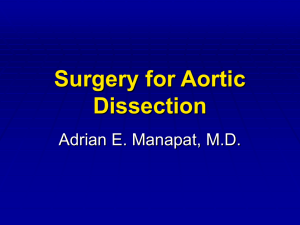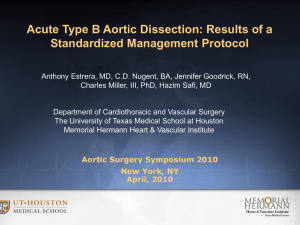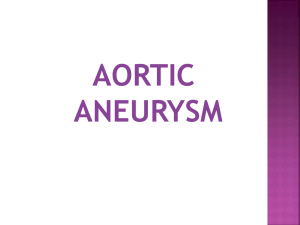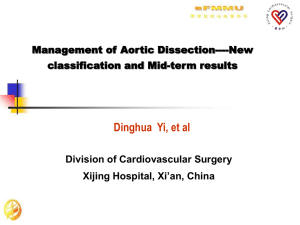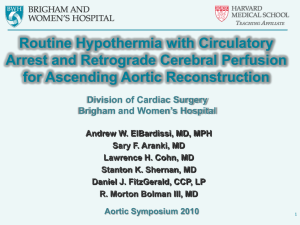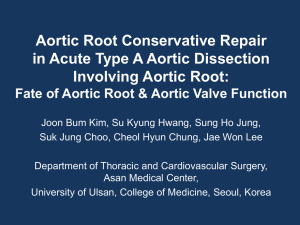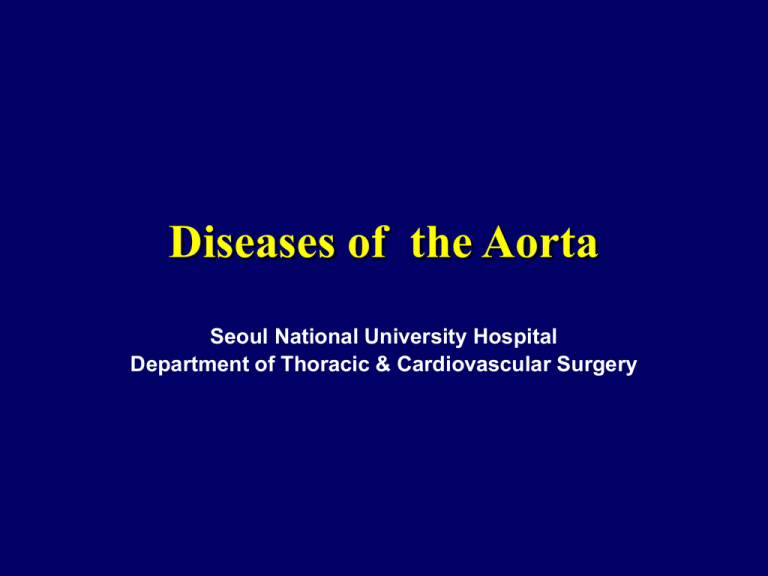
Diseases of the Aorta
Seoul National University Hospital
Department of Thoracic & Cardiovascular Surgery
Anatomy of Aorta
Aortic root
aortic valve, sinus of Valsalva,
coronary artery
Ascending aorta
aortic root ~ innominate
artery
Aortic arch
proximal, distal
Descending thoracic aorta
distal to LSCA ~ 12th ICS
Thoracoabdominal aorta
descending thoracic aorta &
abdominal aorta
Properties of Aorta & Major Conduit
1. Aorta
Compliant vessel (Windkessel function)
; transforms pulsatile hydraulic energy into a more
steady flow by elastic distension & contraction
2. Synthetic conduit
Noncompliant
; must result in alteration of arterial hemodynamics
& LV load (increased impedance & afterload)
Diseases of Thoracic Aorta
Aortic aneurysm
Aortic dissection
Obstructive disease of branches
of the thoracic aorta
Traumatic aortic rupture
Pathophysiology of Aortic Aneurysm
Definition
localized or diffuse dilatation > 50% of normal diam.
Most common aortic disease that require surgery
Etiology
Atherosclerosis ( + underlying weakness)
Chronic aortic dissection
Annuloaortic ectasia (Marfan syndrome)
Trauma
Infection
Associated with aortic valve disease
Histopathology of Ascending
Aortic Aneurysm
1. Cystic medial necrosis by pooling of mucoid
material
2. Elastin fragmentation by disruption of elastin
lamellae
3. Fibrosis as an increase in collagen at the expense
of smooth muscle cells
4. Medionecrosis as areas with apparent loss of
nuclei
Pathophysiology of Ascending AA
Marfan syndrome
Incidence
– 1 / 5,000
Annuloaortic ectasia is very common
Associated defects
– Aortic regurgitation, mitral valve prolapse,
dysrhythmia
– Tall stature, long limbs and digits, anterior
chest deformity, joint laxity, vertebral column
deformity
– High arched palate, lens disorder
Marfan’s Syndrome
* Definition
1)
A heritable disorder (AD) of connective tissue involving
biochemical abnormality of extracellular matrix by a mutation in
fibrillin gene on chromosome 15 (Fibrillin-1, 350-KD glycoprotein :
integral structural component of 10-nm noncollagenous microfibrils
of extracellular matrix in most tissue)
2)
The absence of structural integrity of skeletal, ocular, &
cardiovascular system
3)
Adult patients demonstrate abnormal elastic properties
manifested by decreased aortic distensibility & increased
stiffness index
Marfan’s Syndrome
Clinical manifestations
Cardiovascular
Ocular
Skeletal abnormality
Cardiovascular manifestations
Progress with time
Mitral valve prolapse in 100%
Aortic root dilatation in 80%
Rarely atrial septal aneurysm
Manifestations of Marfan’s Syndrome
1. Patterns of aortic dilatation
1) 80% of the patients shows aortic dilation
2) more commonly generalized form than localized form
3) more commonly aortic regurgitation in generalized form
2. Natural prognosis
1) Life expectancy is significantly reduced (40~50) as a
consequence of aortic dilatation & its complications
(aortic dissection, fatal rupture, AR, heart failure)
Marfan’s Syndrome in Children
1. Diagnosis can be made at any age with marked variation
in clinical expression.
2. Patients without family history (in one third of patients
of all age) have more severe manifestation probably
due to sporadic mutation.
3. Surgery should be carried out even in asymptomatic
patients, once the diameter of the aortic root or
ascending aorta reaches 5 to 6cm as in adults.
4. Mitral valve prolapse is as common as aortic root
dilatation and progression can cause significant
morbidity & mortality.
Patterns of Aortic Aneurysm
Locations of Aneurysm
Ascending aorta
45 %
Aortic arch
10 %
Descending thoracic aorta
35 %
Thoracoabdominal aorta
10 %
Natural History of AA
Aortic aneurysm
Incidence
– 5.9 new aneurysms / 100,000 person-years
Life time probability of rupture : 75~80%
5-yr untreated survival rate
: 10~20%
Median time to rupture
: 2~3 yrs
Size
< 5 cm
6 cm
8 cm
Risk of rupture within 1yr
4%
43 %
80 %
Clinical Presentation of AA
Symptoms & signs
Asymptomatic
Compressive symptoms
–
–
–
–
–
recurrent laryngeal n. or vagus n. : hoarseness
tracheobronchial tree
: dyspnea
pulmonary a. : fistula, bleeding pulmonary HT & edema
esophagus
: dysphagia
stomach
: sensation of satiety wt. loss
Pain aneurysmal expansion
Intestinal angina, renovascular HT
associated atherosclerotic obstructive disease (5% in TAAA)
Physical finding
- usually unremarkable
Wide pulse pressure, diastolic murmur AR
Indications for Aortic Aneurysm
Aneurysm diameter 5cm
Aneurysm with documented enlargement
Symptomatic aneurysm
― chest pain or back pain indicating expansion
― significant aortic regurgitation
Dissecting Aortic Aneurysm
Catastrophic event
Intimal tear
False channel
in the outer half of the
media
highly susceptible to
rupture
Acute dissection
< 2 wks from Sx onset
Chronic dissection
> 2 wks from Sx onset
Pathophysiology of Aortic Dissection
Malperfusion
Reentry
Predisposing Factors of DA
Hypertension
Cystic medial necrosis
Marfan syndrome
AAE(annuloaortic ectasia)
Bicuspid aortic valve
Coarctation
Pregnancy
Chest trauma
Classification of Dissection
Standford
Type A
Involvement of the a-Ao ( arch or d-Ao)
regardless of site of primary intimal tear
Type B
All others without involvement of a-Ao
DeBakey I, II, III
According to the location of intimal tear
Classification of Aortic Dissection
II
A
I
III
B
Natural History of DA
Annual incidence
5~10 / million
Sex ratio
M:F = 2:1 ~ 5:1
Acute dissection
Median time to rupture
: 3 days
Mortality rate ; 50 % within 2 days
75 % within 2 wks
Chronic dissection
Median time to rupture : 1~3 Yrs
Follows patterns of non-dissecting aneurysm
Clinical Presentation of DA
Acute dissection
Excruciating pain
– abrupt onset
– sudden rise to peak
– Chest pain
2/3 of a-Ao dissection
– Back pain
dissection distal to aortic arch
– Pain may migrate as the dissection moves distally.
Various extent of peripheral & central vessel occlusion
– from progression of dissection through the false lumen
Failure of diagnosis : major problem
Clinical Presentation of DA
Type A
Pain
anterior substernal
Type B
Frequency
posterior, midscapular,
abdominal
Syncope
+++
rare
Dyspnea
+
―
Blood pressure
elevated 50%, low 20%
elevated 80%
Asymmetric pulses
upper, lower extremity
lower extremity
30-50%
Diastolic murmur
50%
10%
Pericardial effusion
+++
rare
Pleural effusion
±
+++
Hemiparesis or plegia
+
―
5-6%
Paraparesis or plegia
+
+
2-6%
Renal, intestinal infarction
+
+
3-5%
Myocardial infarction
+
rare
10 %
Principle of Treatment in DA
Type A acute aortic dissection
Emergent operation
Type B acute aortic dissection
Medical Tx and observation unless life
threatening
Surgical indication
– Persistent pain
– Aneurysmal dilatation ( 5cm)
– End organ (kidney, bowel) or limb ischemia
– Evidence of retrograde dissection to the a-Ao
Medical Management of DA
Initial management
Immediate ICU care
BP control & Monitoring
– Central line, arterial line, urine output
Imaging studies
– Daily Chest X-ray, weekly CT scan during
hospitalization
Pharmacologic therapy
Vasodilator : Sodium nitroprusside
β-blocker
: Esmolol (β-1 selective & short acting)
Diagnostic Studies for DA
CT & CT angiography
Aneurysm size, location, extent, intimal tear site
Other pathologies in the chest & abdomen
Follow-up study : aneurysm growth
Limitation
– unreliable detection of root enlargement
Contraindication
– renal insufficiency, allergy to contrast agents
Diagnostic Studies for DA
MRI
Noninvasive study
Do not require contrast medium
Better than CT at detecting aortic root
dilatation
Disadvantages
cost
required time (esp, in acute dissection)
Contraindication
pacemaker, claustrophobia
Diagnostic Studies for DA
Transesophageal Echocardiography (TEE)
Accuracy in imaging intimal tear : 90%
Assessment of cardiac structure & function
Highly sensitive in aortic pathology diagnosis
– aortic valve disease, aortic dilatation, dissection,
thrombi, atherosclerotic disease
Intraoperative monitoring
– check cardiac function, aortic valve competency,
atherosclerosis in the thoracic aorta
Limitation
– requires a skilled cardiologist
Diagnostic Studies for DA
Aortography
Geography of the aorta & condition of smaller vessels
Previous gold standard in dissection
– double lumen, tear site, extent
Indication
– renovascular HT, intermittent claudication, atherosclerotic
occlusive abdominal aorta, symptoms of carotid artery
occlusion
Disadvantages
– invasive procedure using radiopaque dyes
Cardiac cath & coronary angiography
Evaluation of the concomitant coronary artery disease
Surgery of Type A Dissection
Principles of Surgical Tx in Acute Dissection
Resection of aortic segment containing intimal tear
Obliteration of false lumen in both end of remained aorta
Graft replacement of resected aortic segment
Techniques
Median sternotomy
Femoral-femoral bypass
Trendelenburg position
Circulatory arrest with deep hypothermia
Retrograde cerebral perfusion
Reinforcement of the intima & adventitia together
(sandwich technique)
Operation of Type A Dissection
Type A Dissection
Surgery of Acute Type B Dissection
Techniques
Similar to the techniques for aneurysm
Rechanneling blood into the true lumen
Ligation of all intercostal arteries in acute
dissection
Surgical indications
Persistent pain
Aneurysmal dilatation ( 5cm)
End organ(kidney, bowel) or limb ischemia
Evidence of retrograde dissection to the a-Ao
Surgical Results of DA
Acute Type A Dissection
Early mortality : 20~30 %
Main cause of death underlying end-organ injury
Major complications stroke (9%)
Major risk factors for postop. stroke
– pump time, episode of severe hypotension
Acute Type B Dissection
Early mortality : 25~50 %
(cf. medical treatment : 7~32 %)
Major complications : ischemic spinal cord injury
Surgical Treatment of AA
Aneurysm : Aortic Root, a-Ao, Aortic Arch
Historical evolution
1950s : Cardiopulmonary Bypass (Gibbon)
1955 : 1st successful a-Ao repair (Cooley & DeBakey)
1964 : 1st successful replacement of entire a-Ao (Wheat)
– CPB, coronary perfusion, myocardial cooling, cold cardiac arrest
1968 : Composite valve graft (Bentall & de Bono)
1975 : Replacement of entire aortic arch (Griepp)
– profound hypothermia & circulatory arrest
Aortic Root, Ascending Aorta, Aortic Arch
Limitation of profound hypothermia
< 30 min : safe duration
> 45 min : increased incidence of stroke
> 65 min : increased incidence of death
Calculated safe duration of hypothermic circulatory arrest
Temperature
(C)
37
Cerebral Metabolic Rate
(% of baseline)
100
Safe Duration of HCA
(min)
5
30
56 ( 52 ~ 60 )
9 ( 8 ~ 10 )
25
37 ( 33 ~ 42 )
14 ( 12 ~ 15 )
20
24 ( 21 ~ 29 )
21 ( 17 ~ 24 )
15
16 ( 13 ~ 20 )
31 ( 25 ~ 38 )
10
11 ( 8 ~ 14 )
45 ( 36 ~ 62 )
Aortic Root, Ascending Aorta, Aortic Arch
Adjuncts for brain protection
Reintroduction of antegrade
cerebral perfusion (Frist, 1987)
Retrograde cerebral perfusion
(Ueda, 1989)
Aortic Root - Techniques
Median sternotomy
Antegrade and/or retrograde
cardioplegic perfusion
Techniques for aortic root
– Wheat
– Composite graft (esp, for Marfan)
Bentall
Cabrol
modified Cabrol
button
– Homograft
– Valve sparing procedure
Choice of tube graft ; diameter of 10%
smaller than the length of the free
margin of the aortic leaflet
Valve-sparing Operation
Resorting aortic root dimensions in an aortic valve-sparing
operation when aortic annulus is normal and sinotubular
junction is enlarged
Valve-sparing Operation
Resorting aortic root dimensions when aortic annulus &
sinotubular junction are normal, as in aortic dissection
Valve-sparing Operation
Resorting aortic root dimensions when aortic annulus and sinotubular
junction are enlarged, as in anuloaortic ectasia with Marfan syndrome
Valve-sparing Operation
Reconstructing aortic root using a graft with
the aortic valve placed within it
Aortic Root – Wheat Technique
Separate valve/graft replacement
For older patients with mild to moderate sinus
dilatation
Aortic Root – Composite Valve Graft
Bentall technique
Coronary artery reattachment
side-to-side anastomosis
Disadvantage
bleeding d/t anastomosis tension
→ pseudoaneurysm (7~25%)
Aortic Root – Composite Valve Graft
Cabrol technique
Coronary artery reattachment
– a small graft to the both coronary
arteries
– side-to-side anastomosis of the
small graft & composite graft
Advantage
– ↓anastomosis tension
Disadvantage
– kinking at the anastomosis sites
Aortic Root – Composite Valve Graft
Modified Cabrol technique
Coronary artery reattachment
– a small graft to the LCA
– end-to-side anastomosis of the
small graft & composite graft
– button attachment of the RCA
Advantage
– ↓kinking
Aortic Root – Composite valve graft
Button technique
Coronary artery reattachment
Carrel patch for both coronary a.
Direct anastomosis to the
composite graft
Composite Valve Graft
A; aortic valve is excised
B; composite prosthetic valve conduit is
attached to annulus of aortic valve
Surgery of Aortic Root
Results
Early mortality : 2~15%
Early complications : thromboembolism, bleeding
Late complications : endocarditis, thromboembolism
pseudoaneurysm
Technique
Major Complications
30-Day Survival (%)
5-Yr Survival (%)
Wheat
Endocarditis (5%)
85
70
Bentall
Thromboembolism (5~10%),
endocarditis (5%)
85~90
70~85
90
85~95
75
70~85
Cabrol
Button
Thromboembolism (2~10%),
endocarditis (5%)
Surgery of Aortic Root
Results
Ascending Aorta & Arch
Closed technique
Limited to a-Ao
Aorta cross clamp
Open technique
Arch involvement
Deep hypothermia & circulatory arrest
–EEG monitoring
–Retrograde cerebral perfusion
Elephant Trunk Technique
(by Borst, 1988)
for extensive aortic aneurysm
(“mega-aorta”)
Elephant Trunk Technique (Staged op.)
Surgery of Ascending Aorta & Arch
Results
Technique
Major Complications
30-Day Survival (30%)
Not reported
25
Not reported
75
Stroke (2~10%)
85~90
+ Antegrade cerebral perfusion
Stroke (5~6%)
80~100
+ Retrograde cerebral perfusion
Stroke (3%)
95
Normothermia
+ Antegrade cerebral perfusion
TCA with profound hypothermia
Major complications
– stroke, encephalopathy
Major risk factors
– circulatory arrest time, transverse arch involvement
Descending Thoracic & Thoracoabdominal Aorta
Spinal protection
Arterial radicularis magna (Adamkiewicz a.)
Technique
–
–
–
–
–
–
–
–
Shunt
Hypothermic circulatory arrest
Spinal cord cooling
Pharmacologic agent
Sequential aortic clamp
Distal aortic perfusion
CSF drainage
Intercostal artery reattachment (T9~12)
Endovascular Stent Graft
Indications
– Poor surgical candidates for
thoracic aneurysm
– Expected survival time < 5 yrs
Problem
– Endoleaks (→ graft migration)
– Exclusion of intercostal arteries
– Lack of long-term data
Results
– Early mortality : 9%
– Complications
stroke (7%)
paraplegia (3%)
early endoleak (24%)
reintervention (5%)
Thoracoabdominal Aorta
Modified Crawford’s classification for TAAA
Thoracoabdominal Aorta
– Technique
Thoracoabdominal incision
Descending thoracic aorta involvement
Distal aortic perfusion
CSF drainage
Intercostal artery reattachment
(T9~12)
Celiac axis, SMA, IMA, renal arteries
Visceral perfusion
Carrel patch or bypass graft
Thoracoabdominal Aorta
Descending Thoracic & Thoracoabdominal Aorta
Results
Technique
Major Complications
30-Day Survival
(2~15%),
5-Yr Survival
Descending
thoracic
Neurologic deficit
renal failure (14%)
TAAA type I, II
& IV
Neurologic deficit (0~15%),
renal failure (5~25%)
90~95 %
60~75%
TAAA type II,
no adjuncts
Neurologic deficit (30~40%),
renal failure (17%)
78%
35%
TAAA type II,
with adjuncts
Neurologic deficit (12%), renal
failure (7%)
90%
60~70%
50~80%
Risk Factors for poor outcome
– aneurysm extent (type II)
– preop. renal dysfunction
– aortic cross clamp time
Abdominal Aortic Aneurysm
1. Type
Fusiform : most
Sacciform
Dissecting : rare
False
2. Etiology
Atherosclerosis : 90%
Traumatic
Syphilitic
Congenital
Infected
Pregnancy related
Anastomotic
Pathophysiology of Abdominal Aorta
Nature of the aortic wall
1) Contain more elastin, deposition of
cholesterol and calcium
2) Stress factor and turbulent flow due to
origin of major branches
3) Stability of proximal abdominal aorta and
presence of large bifurcation
Hemodynamic factor
Physical factor
Procedures for Abdominal AA
1
2
3
4
5
6
Heparin 1mg/kg IV
Mannitol 0.5g/kg in suprarenal clamp
Inferior mesenteric artery occlusion
Lumbar arteries oversewn
Proximal and distal anastomosis
Reimplantation of inferior mesenteric
artery
Operative Complications
1 Division of parasympathetic and
sympathetic nerves crossing the
proximal common iliac arteries
2 Peripheral embolism
3 Paralytic ileus
4 Aortoenteric fistula


